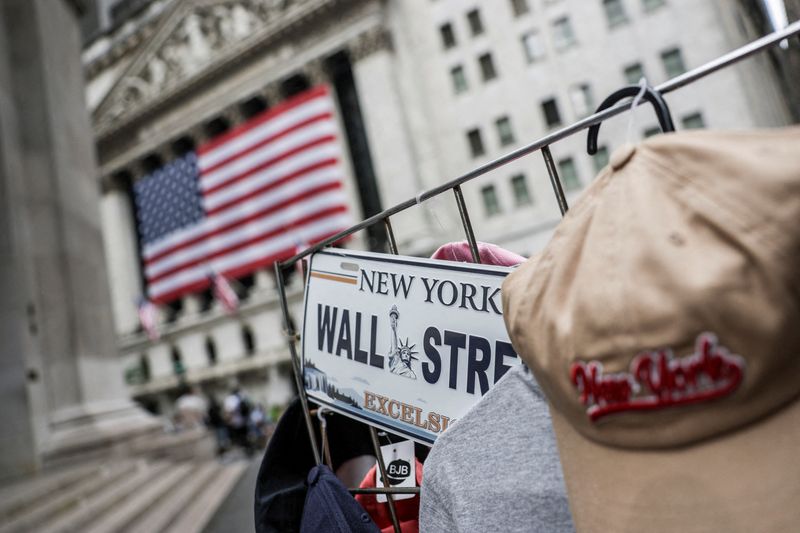
By Naomi Rovnick and Alun John
LONDON (Reuters) -The spectre of U.S. stagflation is stalking global markets, causing some investors to position portfolios to dodge the potential damage that tariffs could wreak on growth and inflation in the world's dominant economy.
Some 70% of global investors surveyed by BofA Global Research in early August said they expect stagflation - the combination of below trend growth and above trend inflation - in the next 12 months.
Recent data showing U.S. labour market weakness, a sharp rise in U.S. core inflation and an unexpected surge in producer prices justifies this concern.
But stocks around the world, including in the United States, remain near record highs and bond markets are calm, suggesting little panic even as U.S. stagflation risks move increasingly onto the radar.
"Stagflation is in the mind of the market, but not the price," said Carmignac fixed income manager Marie-Anne Allier.
Here's a rundown of how U.S. stagflation risks could play out across global markets.
BEWARE BONDS
Persistent inflation, or the fear of it, can pummel longer-dated bonds by eroding the real value of fixed interest payments over time.
Paul Eitelman of Russell Investments, which helps institutions manage more than $1 trillion of assets, said pension funds and insurers have become increasingly nervous about inflation hitting their bond portfolios.
"If we had a another very weak employment report, that would significantly ramp up (U.S. stagflation) concerns," he added.
Nor would non-U.S. bonds offer much protection.
"Interest rates and the long end of the bond curve are highly correlated between the G7 economies," said Mayank Markanday, portfolio manager at Foresight Group. "If you see a big selloff in the long end of the U.S. curve we are likely to see impact on some of the others."
There has already been a selloff in long-dated bonds across major markets. While 2-year yields are lower in the U.S., Germany and Britain this year, 30-year yields are higher.
If sticky inflation stops the Federal Reserve from cutting rates this year, short-dated bonds would suffer too.
WALL STREET WOES
Fidelity International multi-asset manager Caroline Shaw said the group expected U.S. growth to slow and stagflation was one of their two core scenarios.
She remains positive on U.S. big tech stocks but in mid-July bought derivatives called put options that would profit should the more cyclical Russell 2000 small cap index fall.
As with bonds, stocks globally are likely to suffer, even if stagflation is confined to the U.S.
Since 1990, world stocks have fallen by an average of 15% at times when U.S. manufacturing activity data showed both a contraction and higher than average prices, according to State Street head of macro strategy Michael Metcalfe.
But stocks keep surging for now, which Metcalfe says suggests investors think "the disruption to the global trading system isn't going to disrupt big tech earnings."
Markets are ignoring bad news and focusing on the good, said Man Group chief market strategist Kristina Hooper.
"It's like parenting, you only want to see the best in your children, and we're at a stage where it's possible for markets to do that," she said.
SELL THE DOLLAR
Nabil Milali, multi-asset and overlay portfolio manager at Edmond de Rothschild Asset Management, is another investor who says data shows the U.S. economy is heading for stagflation.
He anticipated further weakness in the dollar against the euro.
Stagflation presents twin risks for the greenback, said Milali, because weak growth can devalue a currency and persistent inflation erodes its purchasing power abroad.
The euro is up over 12% against the dollar so far this year. Other currencies like the Japanese yen and Britain's pound have also strengthened.
BUY WHAT, THEN?
Here's where it gets harder, but stagflation could provide another reason to keep buying gold, already the go-to asset class for investors worried about a variety of risks, said Man Group's Hooper.
Other assets that offer protection against inflation could be attractive, such as short-dated inflation linked bonds, said Foresight Group's Markanday.
Professional investors are turning to complex derivatives products like inflation swaps, which rise in value when price indices exceed a certain level, Russell's Eitelman said.
The U.S. two-year inflation linked swap is near its highest in over two years.
(Reporting by Naomi Rovnick and Alun John in London, additional reporting by Stefano Rebaudo in Milan; editing by Dhara Ranasinghe and Christina Fincher)

 Reuters US Economy
Reuters US Economy
 The Motley Fool
The Motley Fool Reuters US Business
Reuters US Business The Atlanta Journal-Constitution Sports
The Atlanta Journal-Constitution Sports OK Magazine
OK Magazine Raw Story
Raw Story